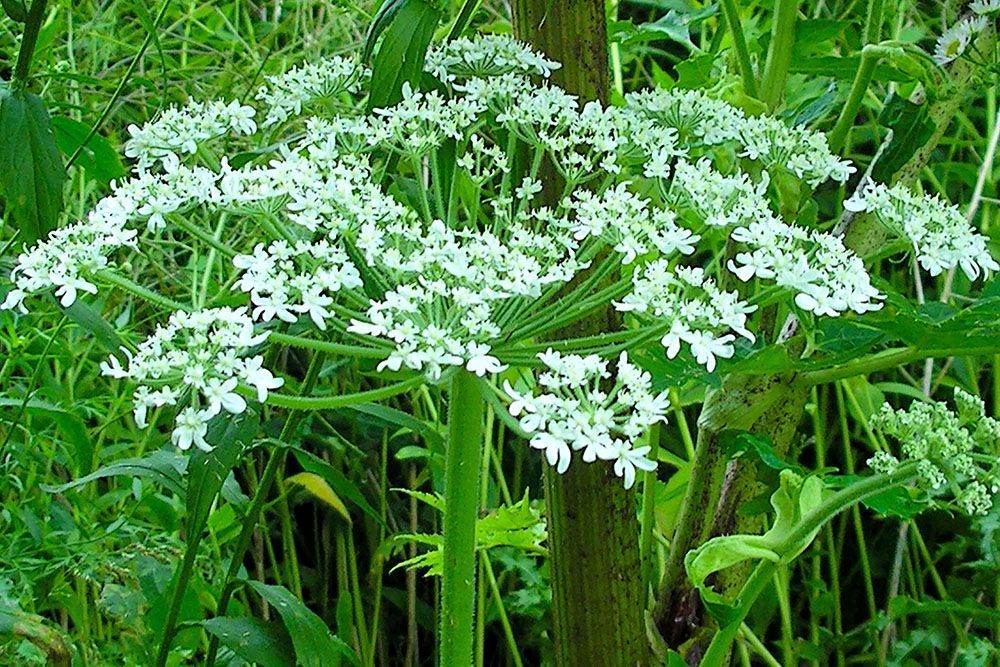Beware of Giant Hogweed

Ausable Bayfield Conservation urges people to avoid contact with invasive Giant Hogweed plant
Plant poses health hazard, can burn skin and affects some people for years; Call your local weed inspector if find Giant Hogweed; Visit abca.ca for fact sheet on identifying, dealing with invasive plant
That plant you find outdoors may be a common and harmless native plant called ‘Purple Angelica’ or it could be the dangerous and invasive ‘Giant Hogweed.’ Ausable Bayfield Conservation Authority (ABCA) staff members advise you to avoid contact with Giant Hogweed. “Giant Hogweed can pose serious harm to humans if touched,” said Angela Van Niekerk, ABCA wetland specialist.
Conservation authority staff have recently received phone calls and reports about Giant Hogweed on ABCA properties and other properties. “We deal with Giant Hogweed if it is found on one of our properties,” said Kate Monk, Manager of Stewardship, Land and Education with ABCA.
Download Giant Hogweed fact sheet:
ABCA removes Giant Hogweed along the banks of its own properties – such as conservation areas – but it is not the landowner of lands along other watercourses so the owners of those lands should contact their local weed inspector. “We advise people to contact their local weed inspector for other properties,” Monk said. “Giant Hogweed is a noxious weed and the weed inspectors will work with the landowner to control the Hogweed.”
A list of weed inspectors is posted on the Ausable Bayfield Conservation website at abca.ca (please scroll down to the bottom of this page for list).
Some people have confused the Purple Angelica plant with Giant Hogweed. Purple Angelica is not noxious but Giant Hogweed is. The conservation authority has updated a fact sheet at abca.ca to show people the difference between the two plants.
Giant Hogweed can be a serious health hazard. If there is skin contact with this plant, the toxins in the sap, activated by direct sunlight, cause severe burns. Contact with the plant can create painful blisters, reddening and swelling of the skin after a day, and inflammation after three days. If the sap comes in contact with the eyes, it may even cause temporary or permanent blindness. Severe dermatitis can affect some people for months. Some people exposed to the plant even stay sensitive for years.
Public health experts say that if you become exposed to Giant Hogweed you should:
1. Wash all affected areas immediately with soap and water if available.
2. Keep affected areas out of direct sunlight.
3. Seek medical advice immediately.
If you find a suspected Giant Hogweed plant, you are advised to report it to the weed inspector at your local municipality and the Invading Species Hotline at 1-800-563-7711. Anyone who finds suspect plants on an Ausable Bayfield Conservation Authority property should call 519-235-2610 or toll-free 1-888-286-2610 or e-mail avanniekerk@abca.ca
People noticing the plant should not get near the plant and should definitely not touch it. Anyone who is able to safely take digital photos (at a distance) of the leaf, stem, and flower, can send the photo to the ABCA.
The mammoth size of the towering Giant Hogweed is the plant’s most distinctive trait. The plant can grow to the size of a full-grown adult and can sometimes reach ten feet in height. For more information visit abca.ca or invadingspecies.com or ontarioweeds.com
LIST OF WEED INSPECTORS:
If you find Giant Hogweed, please contact your local municipal weed inspector:
MUNICIPALITY OF LAMBTON SHORES:
Chris Martin – (519)243-1400 (ext. 8413) or cmartin@lambtonshores.ca
LAMBTON COUNTY:
Duane McKay; Kelly Bedard; Jesse Soetemans
(519) 845-5420 (ext. 5352)
Email: inspect@county-lambton.on.ca
PERTH COUNTY:
Marvin Smith – (519) 291-2236
HURON COUNTY:
Dave Pullen – (519) 524-8394 (Extension 3282) or dpullen@huroncounty.ca
MIDDLESEX COUNTY:
Mark Brown – (519) 434-7321 (ext. 2253) or mbrown@middlesex.ca